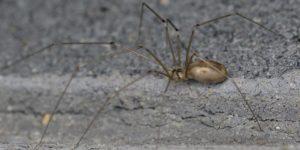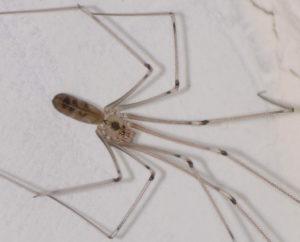Harvest spiders and the arachnid kosinochka of the same name: neighbors and helpers of people
Many spiders boast that they have huge leg lengths. But the leaders are haymaker spiders, whose legs exceed the body length by 20 or more times.
Content
What does a haymaker look like: photo
Description of the spider
Name: Spider-haymaker or centipede
Latin: PholcidaeClass: Arachnida - Arachnida
Squad: Spiders - Araneae
 | Habitats: | everywhere |
 | Dangerous for: | small insects |
 | Attitude towards people: | bites but not venomous |
The haymaker spider itself is tiny, 2-10 mm. The shape may vary, be elongated or spherical. In some individuals, the legs are small, proportionate. The shape and appearance depends on the lifestyle of the spider.
The centipede spider has 4 pairs of eyes, as well as legs. The fangs are small, they cannot hold prey, they are created only for biting it. Most often, haymakers from the middle lane are gray with black spots.
Web and habitat
The haymaker spider is not peculiar web weaving radial shape or with even honeycombs. She is disorderly, untidy and chaotic. But this is not an indicator of lack of ability, but a cunning idea.
The web of an animal of this species is not sticky, and such a disorderly construction contributes to the fact that the victim becomes entangled in this labyrinth. The spider helps the prey by enveloping it even more and immobilizing it, only then it makes a fatal bite.
The haymaker spider can be found everywhere. They often hang upside down on their canvas:
- in caves;
- animal burrows;
- on the trees;
- between plants;
- under stones;
- under the ceiling;
- in the bathrooms;
- bathrooms;
- near the windows.
Spider food
The haymaker spider is picky in the choice of food, has a decent appetite and makes supplies. Food becomes:
- flies;
- beetles;
- butterflies;
- mosquitoes;
- pincers;
- spiders.
Long-legged spiders weave their web and calmly wait for prey. When the future victim gets into the network, she gets tangled, and the spider comes out to her.
It is interesting that the spider has a peculiarity - in case of a threat or when it cannot master the prey, it begins to shake the web very much in order to remain inconspicuous and distract the opponent.
Spider diet in the house
Living next to people, spiders help people clean the room from harmful insects. And in the cold, when food becomes scarce, haymaking spiders go out to hunt for their small-sized counterparts and for other types of spiders.
He also hunts cunningly:
- It turns out, in search of other spiders.
- Gets specifically into someone else's network.
- Begins to swing, pretending to be prey.
- When the owner appears, they grab him and bite him.
Reproduction of the centipede spider
In the conditions of human habitation and a warm climate, weevils can breed all year round. The male that is ready to mate goes out in search of a bride. In the web, he begins to play with strings, attracting a female.
When the spider is ready, she begins to approach the spider, and he strokes her front legs. With calm mating, the spiders live in the same web for some time, but periodically the males die during or after the process.
The female lays her eggs in a cocoon and guards her. Little spiders are tiny, transparent and have short legs. It takes several molts until the offspring becomes like their parents and becomes able to get their own food.
Harvest spider and people
This tiny spider has venom that it uses to kill its victims. But it doesn't harm people. Small fangs cannot bite through human skin. The only unpleasant thing is the presence of cobwebs in the room.
But the haymaker spider is of great benefit. They eat everything that only gets into the network. These are mosquitoes, midges, flies and other harmful insects. Garden pests also get into the web on the site.
Haymaker aka Kosinochka
There is a representative of arachnids, which is called a haymaker. This arthropod rarely lives in the house of people, but in the fall, during the harvesting process, there are a lot of them.
This arthropod also has disproportionately long legs compared to its body. In a pigtail, the body size is up to 15 mm; the legs can reach a length of 15 cm.
These representatives have two eyes and 4 pairs of legs. They do not have poison, but special glands exude an unpleasant odor that repels insects and birds.
In the diet of haymakers:
- spiders;
- pincers;
- slippery;
- snails.
They are scavengers, but can eat plant material, dung particles, and organic debris. They eat not only liquids, but also solid particles.
Features of haymakers
The pigtail is called this arachnid for some of the abilities that it uses for self-defense.
Conclusion
Harvest spiders are people's helpers in the fight against harmful insects. They don't hurt, they don't bite. Their web does not have a beautiful shape and neat honeycombs, but has a cunning design.
Do not confuse them with pigtails, arachnids with long legs, but with a different lifestyle. These haymakers, like the spiders of the same name, are useful, but do not build a web and do not live in people's homes.
Previous


